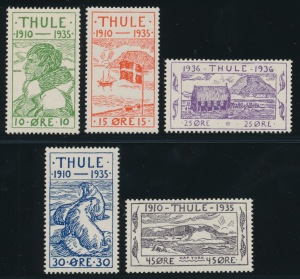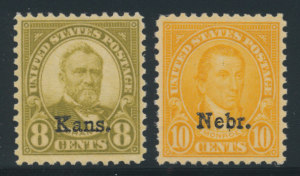
The relationship between privately produced stamps and those for public use is a complex one, and how these stamps are classified has a tremendous impact on their future philatelic popularity. Thule has existed, at least on maps and in cartographers imagination, for over 2,500 years. The name really refers to the far north, and whenever early map makers didn’t know what was farther north than the farthest thing they could document, they called it Thule. Northwestern Greenland is about as far north as you can get, and so, to honor this tradition of the far north being called Thule, that is what these early miners named it. The stamps that they issued were a set of five and were fairly crude. They have the feel of a hasty design by men trying to find something to do during the 24 hour winter nights (they were issued for a mining colony). The status of these stamps is on the order of locals/fantasies. They are not listed in the Scott catalog but are listed in Facit, the specialized Scandinavian catalog, at about $10 per set. As long as I can remember, there has been little demand for this set. They are not common, but because they are not in Scott or Michel, very few collectors seem to want them even though they come from a very popular collecting area—Greenland.
 The relationship between local issues and governmental postal issues is what ultimately determines philatelic popularity because it also determines whether or not the major stamp catalogs will incorporate the stamps in their listings. Without catalog listings, these stamps aren’t in albums, and if they are not in catalogs and albums, most collectors don’t want them. In 1929, the United States issued a series of local stamps for the states of Kansas and Nebraska. There had been some post office robberies in those states, and it was felt that the robberies were an inside job. The feeling was that issuing overprinted stamps for those states and placing them in post offices would prevent the thieves from replacing the stolen stamps back in their post offices and taking out money from current stamp sales. Postal accounting, after the overprinted stamps were issued, needed to be in money or in overprinted stamps in those states, leaving the clerks who had stolen the stamps in the position of having to try to sell the stamps in other states or suborn the fealty of other out of state postal workers to trade the stolen stamps for money. The Kansas-Nebraska were clearly issued from a local need, but because they were issued by a national postal authority and were valid for postage throughout the country rather than just from the local post offices, they have full catalog status in Scott, and accordingly, they are very popular.
The relationship between local issues and governmental postal issues is what ultimately determines philatelic popularity because it also determines whether or not the major stamp catalogs will incorporate the stamps in their listings. Without catalog listings, these stamps aren’t in albums, and if they are not in catalogs and albums, most collectors don’t want them. In 1929, the United States issued a series of local stamps for the states of Kansas and Nebraska. There had been some post office robberies in those states, and it was felt that the robberies were an inside job. The feeling was that issuing overprinted stamps for those states and placing them in post offices would prevent the thieves from replacing the stolen stamps back in their post offices and taking out money from current stamp sales. Postal accounting, after the overprinted stamps were issued, needed to be in money or in overprinted stamps in those states, leaving the clerks who had stolen the stamps in the position of having to try to sell the stamps in other states or suborn the fealty of other out of state postal workers to trade the stolen stamps for money. The Kansas-Nebraska were clearly issued from a local need, but because they were issued by a national postal authority and were valid for postage throughout the country rather than just from the local post offices, they have full catalog status in Scott, and accordingly, they are very popular. Sometimes, Scott changes the status of a listing and the effect is dramatic. The Luxembourg “Intellectual set” pictured above is one such example. Issued in 1935 (the same year as the Thule stamps) by Luxembourg, it was a set that was issued as a Semi-postal, that is, an additional charity value that, in this case was to used to help support (Jewish, left leaning, or gay) intellectuals who were being displaced from their professions by Nazi influence, prior to their being murdered in concentration camps. For many years, despite all evidence that this Luxembourg set met all the legitimacy listing criteria of all the other sets that Scott listed, the “Intellectual set” was not listed by Scott. Rumors abounded about the reasons why with many accusations of antisemitism against George Linn of Linn’s (who was a leader of the anti-listing faction) and against Scott. Scott finally did list this set in their catalog in the late 1970s (forty years after it was listed), and evidence of this situation can still be found in the catalog numbers of these stamps—B65A-Q. There was no room left for these stamps in the catalog listing in 1935, and capital letters after number listings are used to insert new catalog listings at a later date, rather than renumber hundreds of stamps.
Sometimes, Scott changes the status of a listing and the effect is dramatic. The Luxembourg “Intellectual set” pictured above is one such example. Issued in 1935 (the same year as the Thule stamps) by Luxembourg, it was a set that was issued as a Semi-postal, that is, an additional charity value that, in this case was to used to help support (Jewish, left leaning, or gay) intellectuals who were being displaced from their professions by Nazi influence, prior to their being murdered in concentration camps. For many years, despite all evidence that this Luxembourg set met all the legitimacy listing criteria of all the other sets that Scott listed, the “Intellectual set” was not listed by Scott. Rumors abounded about the reasons why with many accusations of antisemitism against George Linn of Linn’s (who was a leader of the anti-listing faction) and against Scott. Scott finally did list this set in their catalog in the late 1970s (forty years after it was listed), and evidence of this situation can still be found in the catalog numbers of these stamps—B65A-Q. There was no room left for these stamps in the catalog listing in 1935, and capital letters after number listings are used to insert new catalog listings at a later date, rather than renumber hundreds of stamps.The price history of these three different ways that catalogs have handled limited types of issues shows just how important main catalog listing is. The Thule locals have always been cheap, even though scarce. The Kansas Nebraska set has been a mainstream US philatelic set and anchors the mid-twentieth century section of thousands of US specialty collections. And the Luxembourg set was hard to both find and sell until Scott listed it in the 1970s. It is now a main set in Luxembourg collections and in collections of how philatelic editors are swayed by their prejudices.
